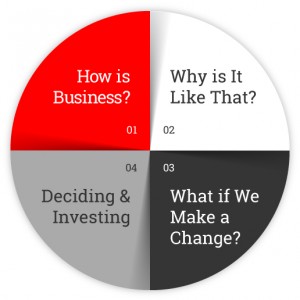With this blog entry we start a series of educational blog entries to explain some of the basic concepts of Business Intelligence, Data Warehousing, and what has been called “Big Data”. We are constantly surprised that many people do not have a handle on some of the simpler ideas and we would like to create a resource for our visitors that will explain some of these ideas so that the whole world of “Big Data” makes more sense.
Way back in the early 90s Bill Inmon stated that the main purpose of a data warehouse was to “support the management decision making process”. This, of course, begged the question:
What is the management decision making process?
Surprisingly few people ask this question. And if you put this question to people in business they usually do not articulate a clear answer.
How’s Business?
How’s Business is the world of reports, dashboards and alerts. It is the plan vs actual. It is the red-amber-green representation or similar. Businesses are overflowing with reports that people think will tell them how their business is. Some reports do, some reports don’t. Any number of vendors will sell you reporting and dashboarding software that will tell you how your business is.
Why?
Of course, when a light turns red, or even if it turns green, the obvious question is “Why”? Why is the business like that? Of course, your “standard reports” are not going to tell you anything about “why”. That takes a human being and some time and some effort and some skills. If it was easy to find out why businesses did not perform as expected many more businesses would be doing a whole lot better!
What if?
Heaven forbid you actually come up with a theory that is plausible about why that light turned red, or even if the light turned green, the next question you will ask is “What can we do about this?” This is the land of “what if” analysis. This is the land of the excel spreadsheet.
Few other tools have been as successful as Excel at addressing the “what if” question.
In the analysis work for the “what if” question we always recommend that the Power Data Analyst comes up with low, medium, high costs proposals that are projected to have low, medium, high impacts on the business. This is so that your management have alternatives to choose from. And all proposals should also be put in to the data warehouse so that they can be evaluated once they have been implemented.
Invest $$$
Of course the Management Decision Making Process centres around the actual go/no go decision for any particular proposal. Some proposals may be very small and the decision can be made by a staff level employee without the need to even talk to a manager.
As a decision costs more money and affects more people and has greater risks the decision must be made further up the management line. The “Big Decisions” are made by the Senior Management Team or the Board of Directors. And in between there are 1,001 decisions being made ever day in large organisations.
The decision to make the investment is usually the focus of what people think is the management decision making process. However, the real work of the management decision making process is in the area of “Why?” and “What if?”. These processes can not be automated to any serious extent because the circumstances that might be causing the out of plan situation can be so many, varied, and complicated.
The people performing the “Why?” and “What if?” work are usually skilled data analysts who have access to a broad array of information.
Meta5: Everywhere good decisions are made
Of course, we argue that Meta5 is the ideal tool for these Power Data Analysts who are charged with the responsibility of figuring out “Why?” and “What if?”.
Meta5 enables these thought leaders to use data in ways never thought of before.
Meta5 makes Excel reporting easy and easily allows for the Power Data Analysts to integrate data from their excel spreadsheets to create the various alternatives in the “What if” phase of work.
Speed of Decisions is a Sustainable Competitive Advantage
As you can clearly see, this process is a never ending cycle just as long as you are in business. There will always be changes and there will always be out of plan situations. There will always be new ideas bubbling up in the company that will need to be decided on.
But what most people do not realize is that the speed with which you can go around this cycle forms a sustainable competitive advantage. If you can go around this cycle faster than your competitors then you will be far more likely to out compete your competitors. You will be able to adjust to the ever changing business environment more quickly. And rapid response translates in to competitive advantage.
Meta5: Fastest Time To Answer.
We at Meta5 know that our software empowers the Power Data Analyst to answer the “Why?” and “What if” questions faster than any other product out there.
If you do not believe that bold claim? We invite you to watch our demonstrations and then call us on 800-886-META555 for a webex demo. We know you will be impressed with what you see.
Meta5: The Better Way.
Thank you for your time and attention
Jim Kanzler.


Leave a Reply